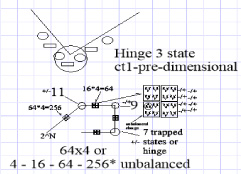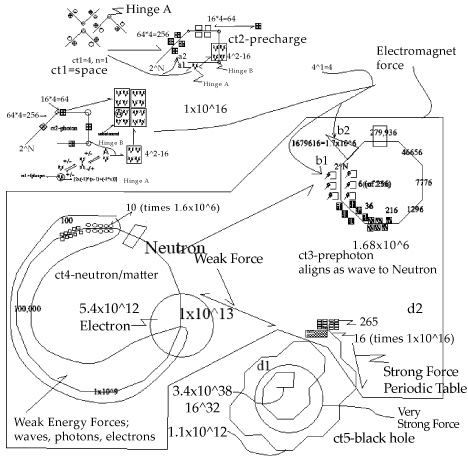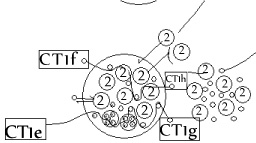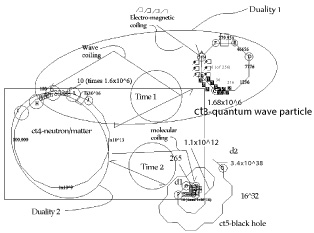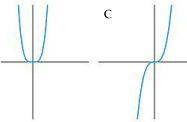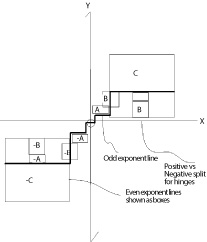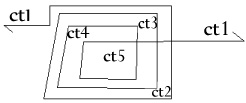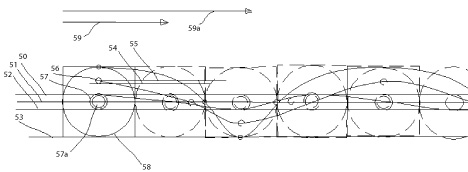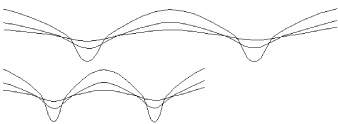Journal Name: Scholar Journal of Applied Sciences and Research
Article Type: Integrative Review
Received date: 21 February, 2019
Accepted date: 06 March, 2019
Published date: 13 March, 2019
Citation: Friedlander GM (2019) Space as the Building Block of Dimension-An Applied Overview. Sch J Appl Sci Res Vol: 2, Issu: 3 (08-16).
Copyright: © 2019 Friedlander GM. This is an openaccess article distributed under the terms of the Creative Commons Attribution License, which permits unrestricted use, distribution, and reproduction in any medium, provided the original author and source are credited.
Abstract
Energy and Matter are the same thing. Space and Energy are the same thing.
Time and change are different. Time is an effect of rearranging dimensions at the range between photons and Neutrons. Change is quantum change, 1, 2, 3, etc.
These conclusions give rise to a different view of Atomic and molecular Structure and force.
A. All dimensions present (at least 5) exist together within the matrix of the universe and in any regional matrix, subgroups of these dimensions are present.
- a. Space has no dimension, precharge exists in a single dimension, prephotons exist in two; neutrons (complete matter) in 3 and black holes in 4. Between prephotons and neutrons are all of the states which we see directly and are manipulated by particle accelerators even though prephotons, precharge and space all exist as quantum states below that level.
- b.The definitions of time and space mean that exchanges of information state (ct state) between space and prephotons occur independent of time. Time as we experience arises essentially at the photon state (10^6 prephotons) and ends with compression to neutrons (10^16 prephotons).
B. All change is quantum change in response to a single variable leading to the universe existing as a series of quantum states or snapshots. Force and time are effects based on the resulting dimensional changes.
C. Time and change are different. Changes in the single variable leads to time, but time is not required for that underlying change nor does it affect that change.
D. Time is an effect like force and dimension of the quantum change between states some of which occur without a time-based reference giving rise to features like wave - particle duality and the impression of charge among other features. By way of example, a particle can only be in one place for each change in x. But once time is applied those multiple locations of the particle give rise to the wave-features of the particle and to its “appearance” as a “Schrodinger’s cat type particle,” one that is two states at once. At once refers to time, but many changes in x can occur affecting low ct state particles position, before any changes in time.
E. Space is made of the same type of information as all other states (energy, matter, black holes) which are folded from space based on exponential compression/folding.
F. Photons, Electrons and protons are examples of transitional states (ct3-ct4) between prephotons (ct3) and neutrons (ct4), Atoms (after hydrogen) and molecular states through neutron stars are transitional states between neutrons (ct4) and black holes (ct5) along with intervening transitional ct3-ct4 states.
Keywords
Energy, Matter, Space, Universe, Quantum, Photons, Electrons, Protons.
Abstract
Energy and Matter are the same thing. Space and Energy are the same thing.
Time and change are different. Time is an effect of rearranging dimensions at the range between photons and Neutrons. Change is quantum change, 1, 2, 3, etc.
These conclusions give rise to a different view of Atomic and molecular Structure and force.
A. All dimensions present (at least 5) exist together within the matrix of the universe and in any regional matrix, subgroups of these dimensions are present.
- a. Space has no dimension, precharge exists in a single dimension, prephotons exist in two; neutrons (complete matter) in 3 and black holes in 4. Between prephotons and neutrons are all of the states which we see directly and are manipulated by particle accelerators even though prephotons, precharge and space all exist as quantum states below that level.
- b.The definitions of time and space mean that exchanges of information state (ct state) between space and prephotons occur independent of time. Time as we experience arises essentially at the photon state (10^6 prephotons) and ends with compression to neutrons (10^16 prephotons).
B. All change is quantum change in response to a single variable leading to the universe existing as a series of quantum states or snapshots. Force and time are effects based on the resulting dimensional changes.
C. Time and change are different. Changes in the single variable leads to time, but time is not required for that underlying change nor does it affect that change.
D. Time is an effect like force and dimension of the quantum change between states some of which occur without a time-based reference giving rise to features like wave - particle duality and the impression of charge among other features. By way of example, a particle can only be in one place for each change in x. But once time is applied those multiple locations of the particle give rise to the wave-features of the particle and to its “appearance” as a “Schrodinger’s cat type particle,” one that is two states at once. At once refers to time, but many changes in x can occur affecting low ct state particles position, before any changes in time.
E. Space is made of the same type of information as all other states (energy, matter, black holes) which are folded from space based on exponential compression/folding.
F. Photons, Electrons and protons are examples of transitional states (ct3-ct4) between prephotons (ct3) and neutrons (ct4), Atoms (after hydrogen) and molecular states through neutron stars are transitional states between neutrons (ct4) and black holes (ct5) along with intervening transitional ct3-ct4 states.
Keywords
Energy, Matter, Space, Universe, Quantum, Photons, Electrons, Protons.
The Denominator of pi and Quantum Snapshots
When you look at a physics equation, the multiple terms must have some common feature or they cannot logically be solved with equalities.
When we see e=mc^2 in some way each of those terms has to be the same as all of the others. This short paper will explain how Energy, Mass and the speed of light can all be the same thing. It will explain how all the features in a more complex equation, like Schrodinger’s (H(t)|ψ(x,t)=iℏd/ dt|ψ(t)=(-ℏ^2/2m)dψ/dx^2 (kinetic)+Vψ ) are all the same thing as, for the equation to be logical, they must be.
This paper is written for the layman and more detail can be found in the references. This paper presents a model, not a theory. A theory is an idea, a model sets that idea out with specific detail. All of the features of the universe discussed in this summary exist around us.
The core of the universe is the denominator of pi, called Fpix herein and is built from -1 according to this formula ([- 1^x plus 2x(-1)^x-1]). The solution for this equation where x=0 is 1.
Built into each solution for fpix is a fuse. This fuse is defined by the evolving value of the solution to fpix.
As the count (x) increases by a quantum amount, a new solution is generated. Each solution starts with the value of 1, but we will start with -3 as the first non-zero solution to fpix. The value of the solution (here -3) is the fuse between the current solution and the next solution to fpix. So, after 3 changes in x, the first solution (-3) changes to (positive) 5. After 5 more changes in x the first solution changes from 5 to -7 and so on. By the time there are 8 changes in x, there are 8 solutions, each having a fuse burning at a slightly different rate and each having a positive or a negative value.
A broad but precise calculation of the number of data points at the universe at this time is possible. At least for the visible universe it is less than 5.2916E+153 and the average fuse length is equal to around one-half this number.
The center of the universe has the slowest fuses, the edges the fastest, and where we live in the middle the fuses are in the middle range, something less than ½ 5x10^153.
There are around 10^44 changes in x every second. At the level of space, solutions change every two beats relative to the adjoining fuse. As the universe is folded, however, very distant changes in fuse state are brought together.
How do We Get from Space to Matter
The transition from space to matter is mathematically controlled by folding which is also called compression:
There are two parts to compression:
- Compression states and
- Hinge States
Specific equations exist for compression:
Hinge State solutions: [2f(n)-1]^[2^n-1] also called Hinge solutions
Compression State solutions: 2f(n)^2^n also called compression solutions
Polynomial approximation features heavily into the observed universe. Hinge states are not directly visible in scale analysis for this reason. Hinge states are considered theoretically necessary to provide a mathematical basis for folding to get compression and they appear in the sin equation for early values of dimension with a pi numerator between -1 and 1.
Compression of space to precharge occurs as the alignment of positive and negative space (ct1) reaches 256. This is done over four stages with a hinge state in between each stage. These stages are referred to as folds because they are basically folding of one state and one dimension to get the next.
Each set of folds results in a force and this first fold from non-dimensional space to precharge gives rise to the force we know as gravity, the transition from non-dimension to one dimension. The unfolding which occurs simultaneously is anti-gravity which is also called dark energy.
Since time does not exist at this level of change, we only experience the net effects. Hence, when you step outside, you are experiencing gravity and anti-gravity, but only the net effect over very many changes in x before time gives the effect to gravity.
The earth represents the continual folding of space into net gravity. So why don’t we get heavier all the time? The answer turns out to be something we observe, something that keeps us alive. It is discussed later.
Net Decompression
Since the universe is expanding, we know that the solutions at this moment in time are “net decompression” solutions of ct2 to ct1. Regionally on earth, we have net compression. Eventually, the earth will decompress and eventually the universe will re-compress. Evidence shows we will go from the current big-bang to a big collapse in about 9 billion years.
The compression rates are shown in Table 1.
Table 1: Compression states.
| f(N) - CT State | 2*f(n) | 2^n | 2f(n)^2n | Dim State | Force prior to | |
|---|---|---|---|---|---|---|
| Next lower states | ct1 states | |||||
| 1 | 2 | 2 | 4 | Space-0 | current | 4 |
| 2 | 4 | 4 | 256 | precharge 1 | Gravity | 256 |
| 3 | 6 | 8 | 1679616 | prephoton | Charge | 429981696 |
| 4 | 10 | 16 | 1E+16 | Neutron/Matter-3 | Energy/Strong/time | 4.29982E+24 |
| 5 | 16 | 32 | 3.40282E+38 | Black hole-4 | Weak/very Strong | 1.46315E+63 |
| 6 | 32 | 64 | 2.13599E+96 | Universe 5 | Unknown | 5.2916E+153 |
N is the number of the compression state and corresponds to the numerator for pi for that dimensional state. The denominator is the derived from fpix for all states.
Each force related to each change is suggested, but a more detailed analysis is given later. Each state folds the next lower state, hence, what a pre photon is 1.7 million ct2 states, it is 43 million ct1 states because each ct2 state is 256 ct1 states.
Proposed Hinge State Structure
A discussion of hinge states is outside of this summary presentation, but a mathematical chart of them is worth discussing, particularly because the math of hinge states proves important in atomic structures (Table 2).
Table 2: Different Hinge ratios.
| N | ct2 states changing | 2f(n)^2n compression ratio | ct1 units CT1 units per quantum | State | 3 Hinge 2F(X)-1^[2^N)-1] Hinges | 3/4 hinge to compression Hinges | 27 times no of ct2 Hinges |
|---|---|---|---|---|---|---|---|
| 1 | 4 | space | |||||
| 2 | 1 | 256 | 256 | charge | 27 | 192 | 27 |
| 3 | 1679616 | 1.68E+06 | 4.30E+08 | photon | 78125 | 3.22E+08 | 4.53E+07 |
| 4 | 1.68E+22 | 1.00E+16 | 4.30E+24 | matter | 2.06E+14 | 3.22E+24 | 4.53E+23 |
| 5 | 5.72E+60 | 3.40E+38 | 1.46E+63 | black hole | 4.31E+37 | 1.10E+63 | 1.54E+62 |
| 6 | 2.07E+151 | 3.62E+90 | 5.29E+153 | U-PART | 2.94E+89 | 3.97E+153 | 5.58E+152 |
A Look at Gravity
What Figure 1 shows is one graphic model for the development of Hinges for ct1 to ct2 states. It begins as just a negative value above two positive values for space. The earliest hinge could, for example, arise as 5,-3,2.
Figure 1: The development of gravity.
There are two “iterated functions” in compressive folding: n1*n2=n2 and 2f(N)^(2^n).
Folding occurs as the first iterated function:
- 4 ct1 space states,
- 4 × 4 (16) folded space states,
- 64 (4 × 16) folded ct1 states, and
- 256 (4 × 64) folded ct1 states to form a single precharge state.
Iterated functions give rise to fractals which are important to the construction of the universe.
Strength of Forces Reflecting AuT
Force Table is shown in Table 3.
Table 3: Force table.
| CT | 2f(n)^2n | Dim State | Force | AuT Force | change | PreAuT | ||
|---|---|---|---|---|---|---|---|---|
| State | compr | prior to | spew | Aut Strength | range | recorded | ||
| 1 | 4 | Space-0 | current | strength | range | |||
| 256 | 1 | Gravity | G/AG | ct1-2-1 | 1 | inf-g | ||
| 2 | 1679616 | 2 | PreCharge | |||||
| ct2-3 | Charge | net sum precharge | variable | ct3-4-3 | inf-EM1 | |||
| 3 | 3 | Prephoton | ct2-3-2 | |||||
| 10^12-10^13 | ct3-4 | P-E interact | net compression | 4.5*10^12-10^16 | P-N | Prot/Elec:abs | ||
| 4 | 1E+16 | ct3-4 | Energy//time | Atomic Prot/Neut abs | e=mc^2 (10^16) | N-P | 10^16 | |
| Transitional | ct4-5 | PostAtom | N-P-N weak | 10^25 | N-N | 10^25 | 10^-15 | |
| Transitional | ct3-4-5 | Forced molecular | N-P-e-P-N:EM | 10^36 | N-P | 10^36 | Inf-EM3 | |
| strong | N-N 2 arms | 10^38 | N-P-E | 10^38 | 10^-18 | |||
| 5 | 3.4028E+38 | ct5 | Very Strong | ct5 collapse | 10^96 | N-BH | ||
| 6 | 2.136E+96 | ct5-6 | Non-Weak | ct5toct6 | 10^96< | BH-U | ||
| 1.6796E+22 | at ct4 | 3*4 | ||||||
| 5.7154E+60 | at ct5 | 3*4*5 | ||||||
AuT initially attempted to work with the strong, weak and electromagnetic force as set out in pre-AuT physics. That effort is partially abandoned.
While those forces appear, pre-AuT physics accepts force as a third system in the universe, whereas AuT sees force merely as the result of folding of dimensional states.
What is beautiful about this chart is that it shows the relative strengths of the strong, weak and gravitational force precisely as they appear in physics. Simply by applying the math of folding, the observed forces are recreated!
This is not true of the electromagnetic force which appears stronger than the model suggests. Here, AuT provides a theory which is not modeled as yet. The theory is that charge occurs as a result of the pre-time folding of ct2 to ct3 (or the unfolding). As the charged particles are brought together at the ct4-5 transition stage they are viewed as electromagnetic fields and the ct4-5 concentration makes them appear stronger than the quantum features which make them up. Hence, they are much higher than the quantum value for charge, but a little lower than the strong force reflected by ct4-5 folding.
Range
Range is the easiest feature of force to deal with.
Dimensions increase and the amount of coordinated information exponentially increase with compression. The effective range of a force is reduced with an increase in dimension because only the higher states are affected. For example, the ct3-4 compression is only experienced within ct3-4 and within ct4-5. At ct2, it is not experienced.
The range is restricted to the compressed state on which the force in question operates. Since compression reduced range (added dimensions reduce space by compressing it further) the molecular range of the strong force and the weak force are both along the first ct5 arms where we live. The molecular range is more than the atomic range because the force is “outside” of the direct ct4-5 alignment and involves transitional ct3-4 states (protons) which are less compressed.
The electromagnetic and gravitational forces are considered infinite. That is not considered accurate for several reasons and the two are dealt with separately.
Gravity involves a non-dimensional state (ct1 space). Hence it may appear infinite because it is not governed by time. In fact, gravity is finite because when ct2 unfolds, the folding that gave rise to the gravity turns into anti-gravity.
This brings us to the second reason they appear infinite.
We only see the net effect of gravity and charge since those changes occur independent of time. We see “constant” gravity even though it fluctuates, and we see “constant charge” for the same reason.
Roughly, we can draw the different forces and their ranges as shown in Figure 4.
Figure 4: Compression information arms from ct1 to 5 with the associated force.
Time
This sounds confusing, separating time and change, so let’s look at what this means.
Figure 2 gives a representation of a cross section of a prephoton. It is made of ct2 states folded together and these ct2 states are made of space folded together. As space moves through the ct3, it rearranges the order within the ct3 state. Likewise, when ct3 unfolds to ct2 it changes and when ct2 folds to ct3 or unfolds to ct1 the structure changes.
Figure 2: Concept drawing of how ct1 decompression changes ct3 history to generate time.
What we call time reflects our ability to “see” the fluctuations in dimension. These fluctuations grow more pronounced with the greater folding between ct3 and ct4. We use digital programming, but when you watch a digital signal it is the same thing. The same feature that gives rise to the movement of the program over time is what gives rise to the time we experience (Figure 3).
Figure 3: The interaction of time and duality over various compression states.
Figure 3 shows how time builds from a poor source of saved information in ct3 states (time 1) to a more complex and full historical record (Time 2) incorporating wave states that exist in the ct3-4-5 matrix.
Our ability to manipulate the universe comes from the time ratio compared the ratio of change. We exist within a dimensional change ratio which allows us to manipulate the x-variable change outside of the bubble.
The speed of light is the maximum rate of change within the bubble. Since some changes (ct1,2 and 3) are completely or partially free of the dimensional changes giving rise to time, they are “faster than the speed of light,” and, as was mentioned before, we only see the net effective change of gravity and charge as a result.
Fractal Geometry
Very quickly I am going to apply this to what we observe.
First, we must experience the transitions of gravity to space around us. Do we see it?
The answer is yes. It is the velocity that moves us. Right now, we are traveling at 790,000 mph because of the unravelling of space.
We see “net” gravity. What prevents us from getting heavier and heavier is that for each of the pre-photon charge particles that protects us from cosmic radiation issuing from the earth, there are (see Table 1) 4.3 × 10^8 ct1 states that have to be folded just to keep us from getting lighter! Each of these escaping ct3 pre-photons has to be “carried” into space on a bed of ct1 states. You see we cannot “move through space” because it is too dense to move through. Instead, space pushes everything else around.
We see this same effect at different fractal levels.
At the atomic level, the neutrons absorb ct1 pulling the other neutrons, protons and electrons inward and “spew” out a field that keeps the atom in motion. The black hole does exactly the same thing. The Quasar is the black hole spewing out these higher states giving spin to the galaxy in which it sits.
A detailed discussion of how this creates the atomic and molecular structures we experience as the periodic table appears in the reference books referred to in this article.
Transition States
As I mentioned between the iterated function 2f(n)^(2^n) is the second iterated function n1*n2=n2.
In between the 2f(n)^2^n, the n1*n2=n2 function gives rise to transitional states. We are obsessed with the transitional states between ct3 and ct4 because that is all we can see directly.
The electron is a transitional state between a complete and partial ct4 state at the twelfth level of compression (T12) in the 16 levels or folds of compression corresponding to 10^16 compression in the compression equation. Because of relative mass issues, this T12 compression state exists within a T13 electron bundle of information. CT4 Transitional State Table is shown in Table 4. The observed “photon” is believed to be a T4, T6 or T8 state.
Table 4: CT4 Transitional State Table. The observed “photon” is believed to be a T4, T6 or T8 state.
| ct4t state | value | cube form | square |
| 16 | $ 10,000,000,000,000,000.00 | 1E+08 | 215443.5 |
| 15 | $ 1,000,000,000,000,000.00 | 31622777 | 100000 |
| 14 | $ 100,000,000,000,000.00 | 10000000 | 46415.89 |
| 13 | $ 10,000,000,000,000.00 | 3162278 | 21544.35 |
| 12 | $ 1,000,000,000,000.00 | 1000000 | 10000 |
| 11 | $ 100,000,000,000.00 | 316227.8 | 4641.589 |
| 10 | $ 10,000,000,000.00 | 100000 | 2154.435 |
| 9 | $ 1,000,000,000.00 | 31622.78 | 1000 |
| 8 | $ 100,000,000.00 | 10000 | 464.1589 |
| 7 | $ 10,000,000.00 | 3162.278 | 215.4435 |
| 6 | $ 1,000,000.00 | 1000 | 100 |
| 5 | $ 100,000.00 | 316.2278 | 46.41589 |
| 4 | $ 10,000.00 | 100 | 21.54435 |
| 3 | $ 1,000.00 | 31.62278 | 10 |
| 2 | $ 100.00 | 10 | 4.641589 |
| 1 | $ 10.00 | 2.154435 |
Odd and Even Exponent Interaction
Figure 5 shows an alternate view to the view shown in Figure 6 where the odd and even exponent results are shown separately.
Figure 5: An alternate view to the view where the odd and even exponent results are shown separately.
Figure 6: The interaction of hinge and compression, odd and even exponent compression shell types.
Between Fractal stable compression states (even exponent states) there are hinge states (odd exponent states). The combination of these results with increased compression shown in the drawings above can be applied to generate drawings showing the interaction of these two mathematical results which is critical to the way that the universe displays information visible to us.
Higher compression states are folded within the lower compression states and this is the reason that black holes appear to disappear. They are folded into a fourth dimensional state (Figure 7).
Figure 7: It shows how larger mass states have smaller dimensional footprints.
Waves
We know there are waves, but all this article has spoken about are quantum states. Even space is a quantum feature. So, what are waves?
Waves are merely another pre-time feature. A discussion of Schrodinger’s equation would go a long way towards this, but that is the subject of another paper entirely. Suffice it to say that waves are nothing more than these quantum points revolving around a central line (Figures 8 and 9).
Figure 8: The results of movement of a square with points offset from a central axis 51 resulting in a curved set of solutions.
Figure 9: Compression of the wavelengths in line with the shorter time frames.
Nomenclature
- X-The count of the universe, counting in sequential quantum whole numbers (1,2,3, etc.). Each number represents a quantum instant for the entire universe.
- Quantum points, quantum data points-individual bits of fpix information which make up the universe. It is estimated there are at least 10^100 of these defining everything from space to black holes. Each has a positive or negative charge for any value of x.
- Fuse, transition fuse (tf)-the number of changes in x between charge changes (fpix progression) for quantum points. The direction of changes at the ct2-ct3 level is believed to be the source of traditional charge with observed electromagnetism being the effect of this charge when compressed at the ct4-5 level and with ct3 prephotons believed to carry electromagnetic charge within space as a result based on whether it is loading or unloading ct2.
- Fpix-the denominator of pi and an equation that separates quantum points of the universe by transition fuses.
- F-series-The Fibonacci series f(n); f-series compression refers to two times this number.
- Exponential compression- 2^n (see information arms).
- Place-Also compression sate defined by the f-series raised to the exponential compression number which defines dimension and is also the numerator of pi for each compression state.
- Information arms-the number of folds represented by exponential compression based on pairing positive and negative lower ct states.
- Transitional states-compression states where the information arms are partially filled or separated by trapped states. Examples are waves, protons, electrons (ct3-ct4); molecules and post hydrogen atoms (ct4-ct5). Transitional states can be described as the transition between a lower state and a higher state. A ct3-ct4 transitional state, such as the electron and proton, are transitional states between waves and neutrons with too many intervening lower ct states to fully collapse into neutrons.
- Fractal States-Stable mathematical structures for transitional solutions (theorized) and include photons, electrons and stable atomic states.
- Hinge states-mathematical solutions having bending solutions, theorized to be odd exponent solutions to compression equations based on (2^n)-1 exponents.
- Compression states-mathematical solutions yielding compression theorized to be even exponent solutions based on 2^n exponents.
- Force-Changes over values of x in the filling of information arms viewed from a time-based analysis. Electromagnetism is theorized to be the loading and unloading of ct2 states onto ct3 information arms; gravity ct1 loading/ unloading onto ct2 information arms. Since the net effect of time free changes is observed from a time-based perspective, we “see” these time independent changes as forces.
- Light speed-The rate change represented by a single ct2 state relative to a ct3 state viewed from a time-based perspective.
- Time-The ratio of ct1 states passing within a ct3-ct4-ct5 transitional state to ct1 states changing outside of the ct3-ct4-ct5 transitional state. This ratio is the source of velocity time dilation. The movement of ct1 states within the ct3-ct4 transitional state alter the arrangement of the ct3 wave states captured between the proton and the electron altering the history of points within the transitional state and the comparison of one collection of points to subsequent arrangements of the same points creates history.
- Electron Bundle-The waves states within ct3-ct4 and ct4-ct5 transitional states which hold the history for a regional mass.
- Gravity-the force created by non-dimensional ct1 solutions being “loaded” onto information arms of ct2.
- Dark Energy (anti-gravity)-the force created by non-dimensional ct1 solutions being unloaded from information arms of ct2. This may include releasing ct1 states trapped within a higher ct state matrix.
- Ct1-space defined by fpix sequential solutions
- Ct2-precharge-The first compression state, unique as coming from a non-dimensional state to a one-dimensional state. Note that the transition between ct1, ct2 and ct3 occur below the level of time and the transitions are therefore partially hidden from a time-based analysis.
- Ct3-prephotons
- Ct4-neutrons-Note that neutrons do not allow for significant passing of ct1 states within the ct4 state due to the compressed nature of the neutrons, so time does not exist within neutrons. The origin of ct3-ct4 waves and time which is the changes to wave forms over the ct4-5 matrix. Squeezing out the waves is the source of gravitational time dilation.
- Ct5-black holes. Molecular states are ct4-ct5 transitional states.
- Ct6 and beyond-theorized higher compression states that form when the total amount of information in the form of ct5 states is properly aligned and sufficient.
- The big bang-A misnomer referring to the time when the collection of compression solutions of ct1 states into higher ct states went from a net positive compression state to a net negative decompressing state reflecting a greater release of ct1 states from higher states than the corresponding entrapment. We are approximately 13 billion years (13billionx10^44 changes in x) from the latest inflection point and approximately 7 billion years from the next inflection point where the universe will begin to contract again based on observed ratios (Algorithm Universe Theory Compendium).
Supplementary
This is a summary article. It gives applications to Physics associated with the article first published for peer review Journal of Physical Mathematics October 24, 2018 (Vol 9 Issue 4) “Algorithm Model defining Dimensional Features.” References are made to “The Original Article” where appropriate. An update to the Original Article is currently being published in the Journal for Advances in Theoretical Physics. Reference to the updated article will be provided in the Drawings link provided below.
Details of this theory can be found in Algorithm Universe Model, 2nd Edition (hereinafter AUM or Algorithm Universe Model) and Algorithm Universe Theory Compendium Volumes 1 6th edition and Vol 2 3rd edition and references are liberally provided where appropriate. Those books are over 800 pages long together. Only the latest editions of these works correspond with this article.
Some drawings with numbers are shared at a free drawings link which can be found here: https:// my.sendinblue.com/users/subscribe/js_id/3ur2i/id/1
The link above allows you to be added to the author’s subscription list after which you will be directed to a link where you can view for Free the PDF drawings for the latest edition of Algorithm Universe Model.
Author’s Publications
- Friedlander G (2019) Algorithm Model defining Dimensional Features. Journal of Physical Mathematics.
- Friedlander G (2019) Algorithm Universe Model a brief description of the origin and effects of dimension.
- Friedlander G (2018) Algorithm Universe Theory Compendium Volumes 1 and 2.
- Friedlander G (2019) Algorithm Universe Model, 2nd edition.
- Friedlander G (2017) Book I, 2nd ed: An Overview of the origin of space time and quantum phenomena.
- Friedlander G (2017) Book II, 2nd ed: The origin of space time and quantum phenomena.
- Friedlander G (2018) Book III, 5th ed: Mathematical Proofs of Supersymmetry.
- Friedlander G (2018) Book IV, 4th: Transition from nondimensional phenomena to space time.
- Friedlander G (2018) Book V, 2nd ed: State Dimension and Time
- Friedlander G (2018) Book VI Dimension, Time and logic
- Friedlander G (2018) Book VII AuT and the Standard Model
- Friedlander G (2018) Book VIII AuT The nature of time as electron movement
- Friedlander G (2016) SPIRALS IN AMBER, SECOND EDITION-The single variable solution to the universe and the origin of quantum mechanics
- Friedlander G (2016) A Spiral in Amber-The origin of Quantum Mechanics
- Friedlander G (2014) Non linear time theory, successor to the Einstein Hologram Universe (out of print)
Conferences
- Friedlander G (2018) Conference on Astrophysics and Particle Physics in Chicago, A model for generating dimension and time.
- Friedlander G Colloquium Speaker (2019) University of South Alabama.
- Friedlander G (2019) APS Session Z08: Particle & fields Theory.
There are no references
